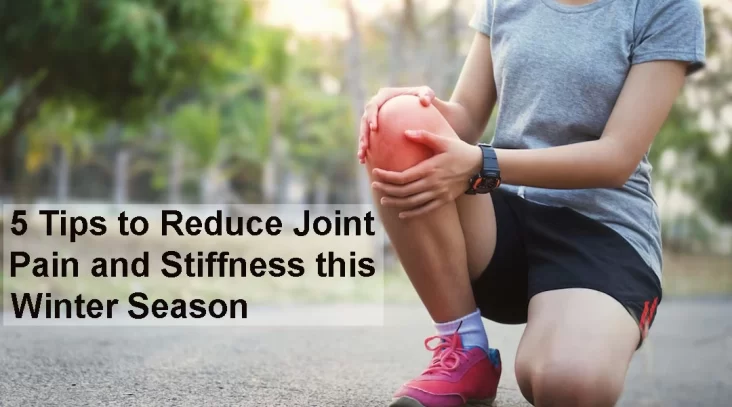For most individuals, winter is a time of excellent health, but for those who suffer from arthritis or persistent joint pain, it can be especially difficult. There are many different reasons why joints can become stiff and painful, but during the winter months, more people tend to complain about decreased mobility, joint discomfort, and stiffness. Colder temperatures put more strain on the tendons and muscles that surround the joints, causing them to expand and causing pain and stiffness as well as decreased mobility. Here are five tips to reduce joint pain and stiffness this winter season that may be useful in providing relief to your joints.
5 Tips to Reduce Joint Pain and Stiffness During Winter
Individuals suffering from joint pain diseases like arthritis, fibromyalgia, or lupus sometimes struggle to get relief from their pain and stiffness. These five at-home suggestions can help you make sure your arms and legs are constantly moving!
Keep Moving
Exercise is the best way to maintain a warm body and flexible joints. Regular exercise not only protects the joints by strengthening the bones and muscles, but it also increases the range of motion and mobility by keeping the joints and muscles from stiffening up. Joint discomfort may arise from inactivity or lack of movement, which can cause stiffness and reduced mobility in the muscles and joints.
Yoga is the finest method to get moving, whether you do it at home or in a group outside. If that isn’t feasible, frequent jogging or walking outside or on a treadmill can be an excellent kind of exercise for your knees and hips. Not just in the winter but all year round, home exercise combined with appropriate stretching can greatly reduce joint discomfort and stiffness.
Stay Hydrated
Although winter is a dry season, individuals often forget how crucial it is to stay hydrated even when they aren’t perspiring or feeling thirsty. Dehydration can still result from the dry air since moisture can still escape via the skin. Dehydration can increase sensitivity to pain and pain and restrict movement because it reduces joint fluid and lubrication. Muscle cramps may also result from this. Thus, remember to periodically restock on water in whatever form. Drinking hot tea, coffee, soups, and other similar drinks is the best approach to keep the body hydrated and warm at the same time.
Keep Warm
Staying warm and covering up is crucial when at home, but it’s even more crucial when venturing outside to avoid flare-ups. Wearing layers and covering up around the knees and hips is very important. It might be advantageous to use thermal knickers to protect the entire body. To keep the hands and feet warm, think about donning gloves and thick socks. Wearing boots or other covered shoes outside might help protect your feet from the elements. Slippers and socks can reduce inflammation even when you’re at home.
When you’re at home, cover up with shawls and sweaters. Put on long, thick trousers to shield your knees. Use a blanket or several blankets to stay warm at night. In order to alleviate uncomfortable symptoms, applying a heating pad or hot water pad over the affected areas can occasionally be helpful. But exercise caution—don’t subject the skin to intense heat for too long!
Get Physical Therapy
Taking a warm bath in a hot tub or pool, if you have access to such, can give your body the essential warmth. This can lessen discomfort and enhance joint mobility. Nonetheless, it’s critical to keep taking pauses and have short sessions to avoid the body becoming overly used to it, which could ultimately decrease its efficacy.
As an alternative, think of physical therapy as an efficient way to manage discomfort. During the winter, physical therapy can help relieve painful muscles and increase blood flow to the joints, which can lessen stiffness and joint discomfort.
Maintain a Healthy Weight
Due to the availability of seasonal meals and the fact that winter is a wonderful time for proper digestion, people tend to overindulge in a variety of treats. Gaining weight is a common occurrence when appetites increase and comfortable blankets provide warmth and cosiness. A few kilogrammes more on the scale might strain the knee and hip joints, particularly in the elderly. Consequently, it’s critical to keep a healthy weight and eat a balanced diet rich in different seasonal fruits and vegetables. Eating a balanced diet helps maintain healthy joints in addition to overall well-being and proper body weight.
Making sure to include fruits and vegetables that reduce inflammation is crucial when determining what to include in the diet. Anti-inflammatory foods include nuts, berries, garlic, oily salmon, and most fruits. These foods can help prevent pain, stiffness, and inflammation.
Conclusion
Without using medications, these five suggestions may help control stiffness, irritation, and pain in the joints at home. To guarantee the best possible care and attention, it is crucial to have an orthopaedic professional examine the joints if there is persistent discomfort and inflammation. This can help you avoid spending time and money on drugs and have a pain-free winter. Get in touch with Sujata Birla Hospital to schedule an appointment with the top orthopaedic specialists in Nashik.


One Comment
Pingback: 5 Tips to Reduce Joint Pain and Stiffness this Winter Season – Sujata Birla Hospital